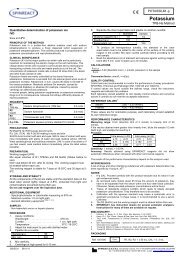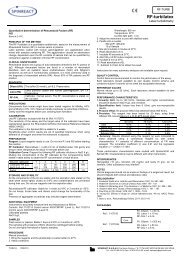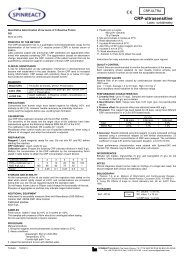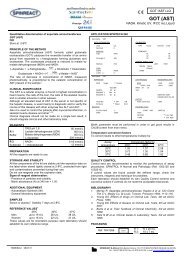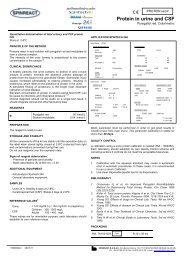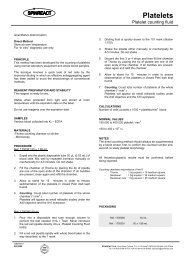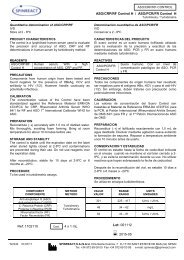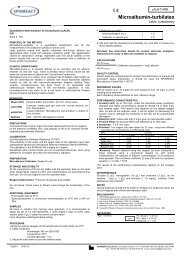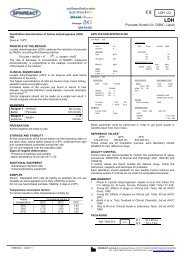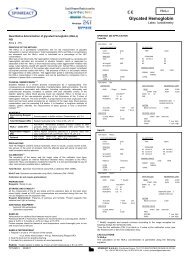N-acetyl-β-D-Glucosaminidase - Spinreact
N-acetyl-β-D-Glucosaminidase - Spinreact
N-acetyl-β-D-Glucosaminidase - Spinreact
You also want an ePaper? Increase the reach of your titles
YUMPU automatically turns print PDFs into web optimized ePapers that Google loves.
Quantitative determination of N-<strong>acetyl</strong>-<strong>β</strong>-D-<strong>Glucosaminidase</strong><br />
(NAG) in urine<br />
IVD<br />
Store at 2-8ºC<br />
PRINCIPLE OF THE METHOD<br />
NAG hydrolyses ammonium 5-[4-(2- acetamido-2-deoxy-beta-Dglucopyranosyloxy)-3-<br />
methoxyphenylmethylene]-2-thioxothiazolidin-<br />
4-one-3-ethanoate (VRA-GlcNAc), the product formation is detected<br />
by development of color at 505nm upon addition of alkaline buffer.<br />
CLINICAL SIGNIFICANCE<br />
NAG is a lysosomal enzyme involved in the breakdown metabolism of<br />
glycoproteins. Increased NAG levels in urine are an early indication of<br />
renal disease and can serve as a valuable renal monitoring test in<br />
disorders such as nephritic syndrome, glomerulunephritis, drug abuse<br />
associated nephrotoxicity, diabetes-associated nephropathy,<br />
hypertension and urinary tract infections.<br />
REAGENTS<br />
R 1<br />
R 2<br />
Citrate acid buffer pH 4.8<br />
VRA-GlcNAc 1mM<br />
Stabilizer<br />
Na2CO3 buffer pH 9.5<br />
Stabilizer<br />
NAG CAL Ref. 1002235<br />
PREPARATION<br />
Reagents are ready to use.<br />
NAG CAL: reconstitute with 2mL of distilled water. Close vial and let<br />
stand for 24 hours at 2-8ºC to equilibrate before using, dissolving<br />
contents completely by swirling gently.<br />
PRECAUTIONS<br />
Solution R1 and NAG CAL contain Sodium Azide. Avoid ingestion or<br />
contact with skin or mucous membranes. In case of skin contact, flush<br />
affected area with copious amounts of water. In case of contact with<br />
eyes or if ingested, seek immediate medical attention. See MSDS for<br />
disposal of the product.<br />
All specimens used in this test should be considered potentially<br />
infectious.<br />
CALIBRATION<br />
Recommend that this assay should be calibrated using NAG<br />
Calibrator ref.1002235 included in the kit.<br />
STORAGE AND STABILITY<br />
R1 and R2 are stable until the expiration date on the label when<br />
stored tightly closed at 2-8ºC, protected from light and contaminations<br />
prevented during their use. Stability: 1 month at 2-8ºC after opening, if<br />
contamination avoided and vials recapped immediately after use.<br />
NAG CAL: Lyophilized NAG calibrator is stable until the expiry date<br />
indicated on the lable when stored at -20ºC. Reconstituted NAG<br />
calibrator is stable for 2 weeks when stored at 2-8 ºC.<br />
Do not use reagents over the expiration date.<br />
Signs of reagent deterioration:<br />
- Presence of particles and turbidity.<br />
ADDITIONAL EQUIPMENT<br />
- Spectrophotometer or colorimeter measuring at 505/700 nm.<br />
- Thermostatic bath at 37ºC ( 0.1ºC)<br />
- Matched cuvettes 1.0 cm light path.<br />
- General laboratory equipment.<br />
SAMPLES<br />
Fresh urine samples should be used when possible. However, urine<br />
samples can be stored for one week at 2-8ºC or up to 1 month at -<br />
20℃ without significantly affecting NAG activity. Samples containing<br />
low amount of preservative can be used (less than 0.02% sodium<br />
azide). NAG activity is pH-sensitive, hence urine samples should<br />
have a pH range between 4.0-8.0.<br />
PROCEDURE<br />
1. Assay conditions:<br />
Wavelength (main/sub): . . . . . . . . . . . .505 nm/700 nm<br />
Cuvette: . . . . . . . . . . . . . . . . . . . . .. . . . 1 cm light path<br />
Constant temperature . . . . . . . . . . . . ………………37ºC<br />
N-<strong>acetyl</strong>-<strong>β</strong>-D-<strong>Glucosaminidase</strong><br />
Colorimetric<br />
2. Pipette into a cuvette:<br />
BEIS50-I 23/06/11 SPINREACT,S.A./S.A.U. Ctra.Santa Coloma, 7 E-17176 SANT ESTEVE DE BAS (GI) SPAIN<br />
Tel. +34 972 69 08 00 Fax +34 972 69 00 99. e-mail: spinreact@spinreact.com<br />
NAG<br />
Reagent blank Sample<br />
Distilled water ( L) 30 --<br />
Sample ( L) -- 30<br />
Reagent 1 ( L) 450 450<br />
3. Mix and incubate for 5 minutes. Read initial absorbance A1.<br />
4. Add:<br />
Reagent 2 ( L) 150 150<br />
5. Mix and incubate for 5 minutes. Read final absorbance A2.<br />
6. Calculate the absorbance change ΔA=A2-A1.<br />
CALCULATIONS<br />
ΔAsample -ΔAblank<br />
NAG (U/L) = × Calibrator value<br />
ΔAcalibrator -ΔAblank<br />
Units: One international unit (IU) is the amount of enzyme that<br />
transforms 1 mol of substrate per minute, in standard conditions. The<br />
concentration is expressed in units per litre of sample (U/L).<br />
QUALITY CONTROL<br />
Control sera are recommended to monitor the performance of assay<br />
procedures: NAG Control ref. 1002237.<br />
If control values are found outside the defined range, check the<br />
instrument, reagents and technique for problems.<br />
Each laboratory should establish its own Quality Control scheme and<br />
corrective actions if controls do not meet the acceptable tolerances.<br />
REFERENCE VALUES<br />
Urine: 0.3 – 12 U/L<br />
These values are for orientation purpose; each laboratory should<br />
establish its own reference range.<br />
PERFORMANCE CHARACTERISTICS<br />
Linearity: The method is linear between of 1 - 300 U/L.<br />
If the results obtained were greater than linearity limit, dilute the sample<br />
1/2 with NaCl 9 g/L and multiply the result by 2.<br />
Precision:<br />
Intra-assay (n=20) Inter-assay (n=5)<br />
Mean (U/L) 40.8 40.8<br />
SD 0.23 0.44<br />
CV (%) 0.55 1.07<br />
Sensitivity: The minimum detectable level that can be distinguished<br />
from zero has been determined as 0.29U/L.<br />
Accuracy: Results obtained using SPINREACT reagents (y) did not<br />
show systematic differences when compared with other commercial<br />
reagents (x).<br />
The results obtained were the following:<br />
Correlation coefficient (r): 0.9996.<br />
Regression equation: y= 1.5655 x + 1.3439<br />
The results of the performance characteristics depend on the analyzer<br />
used.<br />
INTERFERENCES<br />
Bilirrubin (up to 12 mg/dL), Ascorbic acid (up to 60 mg/dL), BSA (up to<br />
100 mg/dL) and Urea (up to 6 g/dL) do not interfere.<br />
NOTES<br />
SPINREACT has instruction sheets for several automatic analyzers.<br />
Instructions for many of them are available on request.<br />
BIBLIOGRAPHY<br />
1. Krishna KS,Kirubakaran MG,Pandey AP,et al.Urinary NAG and AAP in the diagnosis of<br />
graft rejection after live donor renal transplantation. Clin Chim Acta,1985,150(2):69-85.<br />
2.IIstran pocsl et.al. VRA-GlcNAc: novel substrate for N-Acetyl-<strong>β</strong>-D-glucosaminidase<br />
applied to assay of this enzyme in urine.Clinical chemisty, 1990,36(11): 1884-1888<br />
PACKAGING<br />
Ref: 1001072 Cont.<br />
R1: 1x60 mL R2: 1x20 mL<br />
CAL: 1 x 2 mL
Determinación Cuantitativa de N-acetil-<strong>β</strong>-D-Glucosaminidasa<br />
(NAG) en orina<br />
IVD<br />
Conservar a 2-8ºC<br />
PRINCIPIO DEL MÉTODO<br />
NAG hidroliza amonio 5-[4-(2- acetamida-2-deoxi-beta-Dglucopiranosiloxi)-3-metoxifenilmetileno]-2-tioxotiazolidina4-uno-3etanoato<br />
(VRA-GlcNAc), la formación del producto se detecta por el<br />
desarrollo del color a 505nm al añadir un tampón alcalino.<br />
SIGNIFICADO CLÍNICO<br />
NAG es una enzima lisosómica involucrada en la rotura del metabolismo<br />
de glicoproteínas. Niveles altos de NAG en la orina son una indicación<br />
prematura de enfermedad renal y puede servir como una prueba renal<br />
valiosa en desórdenes tales como síndrome nefrítico, glomerulunefritis,<br />
abuso de drogas asociadas con nefrotoxicidad, diabetes asociada con<br />
nefropatía, hipertensión e infecciones del tracto urinario.<br />
REACTIVOS<br />
R 1<br />
R 2<br />
Tampón Citrato ácido pH 4.8<br />
VRA-GlcNAc 1mM<br />
Estabilizador<br />
Tampón Na2CO3 pH 9.5<br />
Estabilizador<br />
NAG CAL Ref. 1002235<br />
PREPARACIÓN<br />
Los reactivos están listos para su uso.<br />
NAG CAL: reconstituir con 2 mL de agua destilada. Cerrar el vial y dejar<br />
reposar durante 24 horas a 2-8ºC para que se equilibre antes de usar,<br />
agitando suavemente para disolver el contenido completamente.<br />
PRECAUCIONES<br />
La solución R1 y NAG CAL contienen Azida de Sodio. Evitar la ingestión o<br />
el contacto con la piel o membranas mucosas. En caso de contacto con la<br />
piel, limpiar la zona afectada con abundante agua. En caso de contacto<br />
con los ojos o ingestión, acudir inmediatamente al médico. Ver MSDS<br />
para disposición del producto<br />
Todos los especímenes utilizados en esta prueba se deben considerar<br />
como potencialmente infecciosos.<br />
CALIBRACIÓN<br />
Se recomienda que la prueba se calibre utilizando el Calibrador NAG<br />
ref.1002235 incluido en el kit.<br />
CONSERVACIÓN Y ESTABILIDAD<br />
R1 y R2 son estables hasta la fecha de caducidad indicada en la etiqueta,<br />
cuando se mantienen bien cerrados a 2-8ºC, protegidos de la luz y se<br />
evita su contaminación durante el uso.<br />
Estabilidad: 1 mes a 2-8ºC una vez abierto, si se evita la contaminación y<br />
los viales se tapan inmediatamente después de su uso.<br />
NAG CAL: El Calibrador NAG liofilizado es estable hasta la fecha de<br />
caducidad indicada en el envase cuando se conserva a -20ºC. El<br />
Calibrador NAG reconstituido es estable durante 2 semanas cuando se<br />
conserva a 2-8ºC.<br />
No utilice reactivos fuera de la fecha indicada.<br />
Indicadores de deterioro de los reactivos:<br />
- Presencia de partículas y turbidez.<br />
MATERIAL ADICIONAL<br />
- Espectrofotómetro o colorímetro para mediciones a 505/700 nm.<br />
- Baño termostático a 37ºC ( 0.1ºC)<br />
- Cubetas de paso de luz de 1,0 cm.<br />
- Equipamiento habitual de laboratorio.<br />
MUESTRAS<br />
Cuando sea posible se deben utilizar muestras frescas de orina. Sin<br />
embargo, las muestras de orina se pueden conservar durante una semana<br />
a 2-8ºC o hasta 1 mes a -20℃ sin afectar la actividad del NAG. Se pueden<br />
utilizar muestras con bajo contenido en persevantes (menos de 0,02% de<br />
azida de sodio). La actividad de NAG es sensible al pH, por lo tanto las<br />
muestras de orina deben tener un pH entre 4.0-8.0.<br />
PROCEDIMIENTO<br />
Condiciones del ensayo:<br />
1. Longitud de onda (principal/sub): . . . . . . . . . . . .505 nm/700<br />
nm<br />
N-acetil-<strong>β</strong>-D-Glucosaminidasa<br />
Colorimétrico<br />
BEIS50-E 23/06/11 SPINREACT,S.A./S.A.U. Ctra.Santa Coloma, 7 E-17176 SANT ESTEVE DE BAS (GI) SPAIN<br />
Tel. +34 972 69 08 00 Fax +34 972 69 00 99. e-mail: spinreact@spinreact.com<br />
NAG<br />
Cubeta: . . . . . . . . . . . . . . . . ……... . . . .. . . . paso de luz de 1 cm<br />
Temperatura constante . . . . …………. . . . . . . . ………………37ºC<br />
1. Pipetear en una cubeta:<br />
Blanco Muestra<br />
Agua destilada ( L) 30 --<br />
Muestra ( L) -- 30<br />
Reactivo 1 ( L) 450 450<br />
2. Mezclar e incubar durante 5 minutos. Leer la absorbancia A1 inicial.<br />
3. Añadir:<br />
Reactivo 2 ( L) 150 150<br />
4. Mezclar e incubar durante 5 minutos. Leer la absorbancia A2 final.<br />
5. Calcular el cambio de absorbancia ΔA=A2-A1.<br />
CÁLCULOS<br />
ΔAmuestra -ΔAblanco<br />
NAG (U/L) = × Valor Calibrador<br />
ΔAcalibrador -ΔAblanco<br />
Unidades: Una unidad internacional (UI) es la cantidad de enzima que<br />
convierte 1 moL de sustrato por minuto, en condiciones estándar. La<br />
concentración se expresa en unidades por litro (U/L).<br />
CONTROL DE CALIDAD<br />
Es conveniente analizar junto con las muestras control valorados: Control<br />
NAG ref. 1002237.<br />
Si los valores de control están fuera del rango definido, se debe revisar el<br />
instrumento, los reactivos y la técnica.<br />
Cada laboratorio deberá disponer su propio Control de Calidad y establecer<br />
correcciones en el caso que los controles no cumplan con las tolerancias.<br />
VALORES DE REFERENCIA<br />
Orina: 0.3 – 12 U/L<br />
Estos valores son orientativos. Es recomendable que cada laboratorio<br />
establezca sus propios valores de referencia.<br />
CARACTERÍSTICAS DEL MÉTODO<br />
Linealidad: La prueba es lineal entre 1 - 300 U/L.<br />
Si los resultados obtenidos fuesen mayores que el límite de linealidad, diluir<br />
1/2 con NaCl 9 g/L y multiplicar el resultado por 2.<br />
Precisión:<br />
Intraserie (n=20) Interserie (n=5)<br />
Media (U/L) 40.8 40.8<br />
SD 0.23 0.44<br />
CV (%) 0.55 1.07<br />
Sensibilidad: La concentración mínima detectable es 0,29U/L.<br />
Exactitud: Los reactivos SPINREACT (y) no muestran diferencias<br />
sistemáticas significativas cuando se comparan con otros reactivos<br />
comerciales (x).<br />
Los resultados obtenidos fueron los siguientes:<br />
Coeficiente de correlación (r): 0.9996.<br />
Ecuación de la recta de regresión: y= 1,5655x + 1,3439<br />
Las características del método varían según el analizador utilizado.<br />
INTERFERENCIAS<br />
No se han observado interferencias con Bilirrubina (hasta 12 mg/dL), ácido<br />
ascórbico (hasta 60 mg/dL), BSA (hasta 100 mg/dL) y Urea (hasta 6 g/dL).<br />
NOTAS<br />
SPINREACT dispone de instrucciones detalladas para la aplicación de<br />
este reactivo en distintos analizadores.<br />
BIBLIOGRAFÍA<br />
1. Krishna KS,Kirubakaran MG,Pandey AP,et al.Urinary NAG and AAP in the<br />
diagnosis of graft rejection after live donor renal transplantation. Clin Chim<br />
Acta,1985,150(2):69-85.<br />
2.IIstran pocsl et.al. VRA-GlcNAc: novel substrate for N-Acetyl-<strong>β</strong>-Dglucosaminidase<br />
applied to assay of this enzyme in urine.Clinical chemisty,<br />
1990,36(11): 1884-1888<br />
PRESENTACIÓN<br />
Ref: 1001072 Cont.<br />
R1: 1x60 mL R2: 1x20 mL<br />
CAL: 1 x 2 mL



